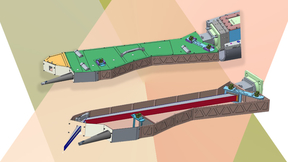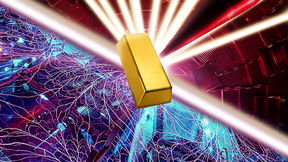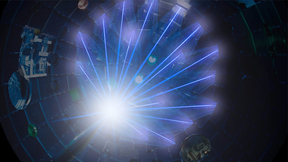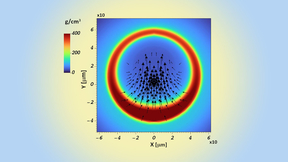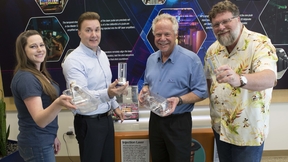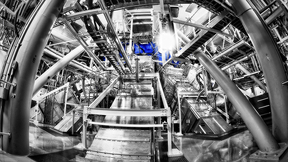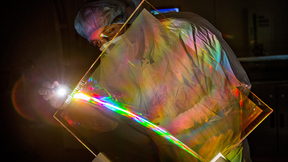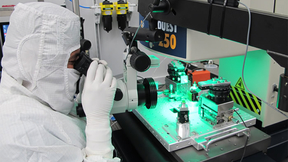Back
An international team led by scientists from the University of Oxford Department of Physics, the University of Rochester and the University of Chicago turned to Lawrence Livermore National Laboratory’s (LLNL’s) National Ignition Facility (NIF) to help unravel the inner workings of heat conduction in clusters of galaxies — the largest structures in the universe. These…
Research conducted at Lawrence Livermore National Laboratory (LLNL) is taking a closer look at entropy — the measure of internal energy per unit temperature that is unavailable for doing useful work — in experiments at the National Ignition Facility (NIF). Work by LLNL physicist Peter Amendt is highlighted as an Editor’s Pick in Physics of Plasma, showing that an added…
Scientists at Lawrence Livermore National Laboratory (LLNL) have collaborated with Princeton Plasma Physics Laboratory (PPPL) to design a novel X-ray crystal spectrometer to provide high-resolution measurements of a challenging feature of high energy density (HED) matter produced by National Ignition Facility (NIF) experiments. The work is featured in a paper in the Review…
To test the Standard Model of particle physics, scientists often collide particles using gigantic underground rings. In a similar fashion, high-pressure physicists compress materials to ever greater pressures to further test the quantum theory of condensed matter and challenge predictions made using the most powerful computers. Pressures exceeding 1 million atmospheres are…
In inertial confinement fusion (ICF) experiments at the National Ignition Facility (NIF), a spherical shell of deuterium-tritium fuel is imploded in an attempt to reach the conditions needed for fusion, self-heating and eventual ignition. Since theory and simulations indicate that ignition efficacy in one-dimension (1D) improves with increasing imploded fuel convergence…
Scientists from Lawrence Livermore National Laboratory (LLNL) and the Laboratory for Laser Energetics (LLE) are working to improve polar direct drive (PDD) neutron sources on the National Ignition Facility (NIF), the world’s most energetic laser. PDD neutron sources are capsules filled with deuterium-tritium (DT) gas at ambient temperature and shot with robust laser pulses…
An influential Department of Energy (DOE) advisory committee has recommended that the nation move aggressively toward the deployment of fusion energy, including investments in technology and equipment to support one of the core missions of LLNL’s National Ignition Facility (NIF) — laying the groundwork for the development of inertial fusion energy (IFE). The report,…
Inertial confinement fusion (ICF) implosions require very high levels of symmetry in order to reach the high densities and temperatures required for fusion induced self-heating. Even percent-level deviations from perfect spherical symmetry can lead to significant distortions of the implosion and ultimately degrade fusion performance. To that end, researchers from Lawrence…
In an effort to better understand how materials deform under extreme conditions, researchers at Lawrence Livermore National Laboratory (LLNL) have developed a new experimental method for probing large-strain and high-rate material strength. In a paper recently published in Acta Materialia, Jonathan Lind, LLNL physicist and lead author, said results of the work aid in…
Carbon is one of the most ubiquitous elements in existence. As the fourth most abundant element in the universe, a building block for all known life and a material that sits in the interior of carbon-rich exoplanets, the element has been subject to intense investigation by scientists. Decades of studies have shown that carbon’s crystal structure has a significant impact on…
Lawrence Livermore National Laboratory’s (LLNL) National Ignition Facility (NIF) laser system has set a new record, firing 2.15 megajoules (MJ) of energy to its target chamber -- a 15 percent improvement over NIF’s design specification of 1.8 MJ, and more than 10 percent higher than the previous 1.9 MJ energy record set in March 2012. This demonstration shot successfully…
An experimental campaign conducted at Lawrence Livermore National Laboratory’s (LLNL) National Ignition Facility (NIF) has achieved a total fusion neutron yield of 1.9e16 (1.9x1016) and 54 KJ of fusion energy output -- double the previous record. Researchers in LLNL’s Inertial Confinement Fusion Program (ICF) detail the results in a paper that will be published this week…
In a paper published today by Nature Astronomy, a team of researchers from Lawrence Livermore National Laboratory (LLNL), Princeton University, Johns Hopkins University and the University of Rochester have provided the first experimentally based mass-radius relationship for a hypothetical pure iron planet at super-Earth core conditions. This discovery can be used to…
In 2017, after more than eight years of operation, the National Ignition Facility (NIF) at Lawrence Livermore National Laboratory (LLNL) reached its epic 2,000th shot. Over that time, as the shot rate steadily climbed, other important numbers also have risen dramatically. By the end of 2017, the total number of people exposed first-hand to NIF’s world-class technology and…
Lawrence Livermore National Laboratory (LLNL) researcher John Heebner has been elected a fellow of The Optical Society of America (OSA). Heebner was cited for his "numerous innovations, achievements and technical leadership in high-energy laser systems and integrated optics including nonlinear optical microresonators and ultrafast light deflectors." Heebner leads the…
Since its introduction in the 1977 film "Star Wars," the Death Star has remained one of science fiction’s most iconic figures. The image of Alderaan’s destruction at the hands of the Death Star’s superlaser is burned into the memory of millions of fans. Scientists and laser experts have maintained that this superbeam could never work due to the properties of lasers --…
A new anti-reflective coating and a novel chemical process for laser optics, developed by Lawrence Livermore National Laboratory (LLNL) researchers, represents an important breakthrough in its effort to boost the energy of the National Ignition Facility’s (NIF) 192 giant lasers, and cut the cost of repairing or replacing damaged optics vital to its operation. The coating…
Considering that nothing precious comes from an online retailer without protective padding, could precision laser targets also benefit from similar high-tech swaddling? So far the answer is yes, for a group of scientists developing new target technologies for NIF that are intended to neutralize what they believe is one of the bigger challenges to achieving ignition. The…
While multitasking may be easy for some people (and perhaps hard for others), it can be a particular challenge for the highly specialized equipment used to carry out experiments on the National Ignition Facility (NIF). But TanDM, NIF’s new Target and Diagnostic Manipulator, is designed to do just that. To date, it is proving itself more than up to the job of performing as…
LIVERMORE, California – On Sept. 18, the National Ignition Facility (NIF) performed its 400th experiment of fiscal year (FY) 2016, meeting the year's goal several weeks early. In comparison, the facility completed 356 experiments in FY15 and 191 experiments in FY14. NIF is on track to complete 415 experiments by the end of the fiscal year, more than doubling its FY14…



